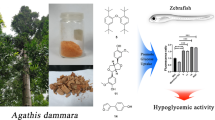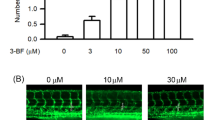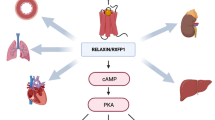Abstract
3′,4′-Dihydroxyflavonol (DiOHF) exerts endothelium-independent relaxation in rat aortic rings. In this study, we hypothesized that DiOHF reduces vascular contraction through Ca2+ desensitization in permeabilized third-order branches of rat mesenteric arteries. The third-order branches of rat mesenteric arteries were permeabilized with β-escin and subjected to tension measurement. Cumulative addition of phenylephrine (0.3–30 μM) produced concentration-dependent vascular contraction of endothelium-intact and endothelium-denuded arterial rings, which were inhibited by pretreatment with DiOHF (10, 30, or 100 μM). In addition, DiOHF dose-dependently decreased vascular contractions induced by 3.0 μM phenylephrine. β-Escin-permeabilized third-order branches of mesenteric arteries were contracted with Ca2+, NaF, or guanosine-5′-(γ-thio)triphosphate (GTPγS) 30 min after pretreatment with DiOHF or vehicle. Pretreatment with DiOHF for 30 min inhibited vascular contraction induced by cumulative additions of Ca2+ (pCa 9.0–6.0) or NaF (4.0–16.0 mM) in permeabilized arterial rings. Cumulative addition of DiOHF also reduced vascular contraction induced by Ca2+-controlled solution of pCa 6.0, 16.0 mM NaF, or 100 μM GTPγS in permeabilized arterial rings. DiOHF inhibited the increase in vascular tension provoked by calyculin A, even though it did not affect vascular tension already produced by calyculin A. DiOHF accelerated the relaxation induced by rapidly lowering Ca2+. DiOHF reduced vascular contraction through Ca2+ desensitization in permeabilized third-order branches of rat mesenteric arteries. These results suggest that DiOHF may have a therapeutic potential in the treatment of cardiovascular diseases.










Similar content being viewed by others
Abbreviations
- AlF −4 :
-
Aluminum tetrafluoride
- [Ca2+]i :
-
Intracellular free calcium concentration
- CPI17:
-
PKC-potentiated inhibitory protein for heterotrimeric MLCP of 17 kDa
- DiOHF:
-
3′,4′-Dihydroxyflavonol
- EGTA:
-
Ethylene glycol bis(2-aminoethyl ether)-N,N,N′N′-tetraacetic acid
- GPCRs:
-
G protein-coupled receptors
- GTP:
-
Guanosine-5′-triphosphate
- GTPγS:
-
Guanosine-5′-(γ-thio)triphosphate
- MLC:
-
Myosin light chain
- MLCK:
-
Myosin light chain kinase
- MLCP:
-
Myosin light chain phosphatase
- MYPT1:
-
Myosin phosphatase targeting subunit 1
- NaF:
-
Sodium fluoride
- pCa:
-
−log [Ca2+]
- PDBu:
-
Phorbol 12,13-dibutyrate
- PIPES:
-
Piperazine-1,4-bis(2-ethanesulfonic acid)
- PKC:
-
Protein kinase C
- SPC:
-
Sphingosylphosphorylcholine
- SR:
-
Sarcoplasmic reticulum
References
Antonny B, Sukumar M, Bigay J, Chabre M, Higashijima T (1993) The mechanism of aluminum-independent G-protein activation by fluoride and magnesium. 31P NMR spectroscopy and fluorescence kinetic studies. J Biol Chem 268:2393–2402
Baek I, Jeon SB, Song MJ, Yang E, Sohn UD, Kim IK (2009) Flavone attenuates vascular contractions by inhibiting RhoA/Rho kinase pathway. Korean J Physiol Pharmacol 13:201–207
Blackmore PF, Exton JH (1986) Studies on the hepatic calcium-mobilizing activity of aluminum fluoride and glucagon. Modulation by cAMP and phorbol myristate acetate. J Biol Chem 261:11056–11063
Burda S, Oleszek W (2001) Antioxidant and antiradical activities of flavonoids. J Agric Food Chem 49:2774–2779
Chan EC, Pannangpetch P, Woodman OL (2000) Relaxation to flavones and flavonols in rat isolated thoracic aorta: mechanism of action and structure–activity relationships. J Cardiovasc Pharmacol 35:326–333
Chan EC, Drummond GR, Woodman OL (2003) 3′, 4′-Dihydroxyflavonol enhances nitric oxide bioavailability and improves vascular function after ischemia and reperfusion injury in the rat. J Cardiovasc Pharmacol 42:727–735
Choi SK, Ahn DS, Lee YH (2009) Comparison of contractile mechanisms of sphingosylphosphorylcholine and sphingosine-1-phosphate in rabbit coronary artery. Cardiovasc Res 82:324–332
Cockcroft S, Taylor JA (1987) Fluoroaluminates mimic guanosine 5′-[gamma-thio]triphosphate in activating the polyphosphoinositide phosphodiesterase of hepatocyte membranes. Role for the guanine nucleotide regulatory protein Gp in signal transduction. Biochem J 241:409–414
Engler MB, Engler MM (2006) The emerging role of flavonoid-rich cocoa and chocolate in cardiovascular health and disease. Nutr Rev 64:109–118
Eto M, Ohmori T, Suzuki M, Furuya K, Morita F (1995) A novel protein phosphatase-1 inhibitory protein potentiated by protein kinase C. Isolation from porcine aorta media and characterization. J Biochem (Tokyo) 118:1104–1107
Fujita A, Takeuchi T, Nakajima H, Nishio H, Hata F (1995) Involvement of heterotrimeric GTP-binding protein and Rho protein, but not protein kinase C, in agonist-induced Ca2+ sensitization of skinned muscle of guinea pig vas deferens. J Pharmacol Exp Ther 274:555–561
Fujiwara T, Itoh T, Kubota Y, Kuriyama H (1989) Effects of guanosine nucleotides on skinned smooth muscle tissue of the rabbit mesenteric artery. J Physiol 408:535–547
Gilman AG (1984) Guanine nucleotide-binding regulatory proteins and dual control of adenylate cyclase. J Clin Invest 73:1–4
Gong MC, Iizuka K, Nixon G, Browne JP, Hall A, Eccleston JF, Sugai M, Kobayashi S, Somlyo AV, Somlyo AP (1996) Role of guanine nucleotide-binding proteins—ras-family or trimeric proteins or both—in Ca2+ sensitization of smooth muscle. Proc Natl Acad Sci USA 93:1340–1345
Hirano K (2007) Current topics in the regulatory mechanism underlying the Ca2+ sensitization of the contractile apparatus in vascular smooth muscle. J Pharmacol Sci 104:109–115
Ito M, Nakano T, Erdodi F, Hartshorne DJ (2004) Myosin phosphatase: structure, regulation and function. Mol Cell Biochem 259:197–209
Jeon SB, Jin F, Kim JI, Kim SH, Suk K, Chae SC, Jun JE, Park WH, Kim IK (2006) A role for Rho kinase in vascular contraction evoked by sodium fluoride. Biochem Biophys Res Commun 343:27–33
Johnson RP, El-Yazbi AF, Takeya K, Walsh EJ, Walsh MP, Cole WC (2009) Ca2+ sensitization via phosphorylation of myosin phosphatase targeting subunit at threonine-855 by Rho kinase contributes to the arterial myogenic response. J Physiol 587:2537–2553
Kanaho Y, Moss J, Vaughan M (1985) Mechanism of inhibition of transducin GTPase activity by fluoride and aluminum. J Biol Chem 260:11493–11497
Kitazawa T, Kobayashi S, Horiuchi K, Somlyo AV, Somlyo AP (1989) Receptor-coupled, permeabilized smooth muscle. J Biol Chem 264:5339–5342
Kitazawa T, Masuo M, Somlyo AP (1991) G protein-mediated inhibition of myosin light-chain phosphatase in vascular smooth muscle. Proc Natl Acad Sci U S A 88:9307–9310
Kitazawa T, Takizawa N, Ikebe M, Eto M (1999) Reconstitution of protein kinase C-induced contractile Ca2+ sensitization in triton X-100-demembranated rabbit arterial smooth muscle. J Physiol 520:139–152
Kizub IV, Pavlova OO, Johnson CD, Soloviev AI, Zholos AV (2010) Rho kinase and protein kinase C involvement in vascular smooth muscle myofilament calcium sensitization in arteries from diabetic rats. Br J Pharmacol 159:1724–1731
Mbikou P, Fajmut A, Brumen M, Roux E (2011) Contribution of Rho kinase to the early phase of the calcium-contraction coupling in airway smooth muscle. Exp Physiol 96:240–258
Murthy KS, Makhlouf GM (1994) Fluoride activates G protein-dependent and -independent pathways in dispersed intestinal smooth muscle cells. Biochem Biophys Res Commun 202:1681–1687
Niiro N, Koga Y, Ikebe M (2003) Agonist-induced changes in the phosphorylation of the myosin-binding subunit of myosin light chain phosphatase and CPI17, two regulatory factors of myosin light chain phosphatase, in smooth muscle. Biochem J 369:117–128
Nishimura J, Kolber M, Breemen C (1988) Norepinephrine and GTPγS increase myofilament Ca2+ sensitivity in α-toxin-permeabilized arterial smooth muscle. Biochem Biophys Res Commun 157:677–683
Otto B, Steusloff A, Just I, Aktories K, Pfitzer G (1996) Role of Rho proteins in carbachol-induced contractions in intact and permeabilized guinea-pig intestinal smooth muscle. J Physiol 496:317–329
Pietta PG (2000) Flavonoids as antioxidants. J Nat Prod 63:1035–1042
Qin CX, Chen X, Hughes RA, Williams SJ, Woodman OL (2008) Understanding the cardioprotective effects of flavonols: discovery of relaxant flavonols without antioxidant activity. J Med Chem 51:1874–1884
Ryu SK, Ahn DS, Cho YE, Choi SK, Kim YH, Morgan KG, Lee YH (2006) Augmented sphingosylphosphorylcholine-induced Ca2+-sensitization of mesenteric artery contraction in spontaneously hypertensive rat. Naunyn Schmiedebergs Arch Pharmacol 373:30–36
Somlyo AP, Somlyo AV (2003) Ca2+ sensitivity of smooth muscle and nonmuscle myosin II: modulated by G proteins, kinases, and myosin phosphatase. Physiol Rev 83:1325–1358
Song MJ, Baek I, Seo M, Kim SH, Suk K, Woodman OL, Williams SJ, Kim IK (2010) Effects of 3′,4′-dihydroxyflavonol on vascular contraction in rat aortic rings. Clin Exp Pharmacol Physiol 37:803–810
Todoroki-Ikeda N, Mizukami Y, Mogami K, Kusuda T, Yamamoto K, Miyake T, Sato M, Suzuki S, Yamagata H, Hokazono Y, Kobayashi S (2000) Sphingosylphosphorylcholine induces Ca2+-sensitization of vascular smooth muscle contraction: possible involvement of rho-kinase. FEBS Lett 482:85–90
Wang S, Dusting GJ, May CN, Woodman OL (2004) 3′,4′-Dihydroxyflavonol reduces infarct size and injury associated with myocardial ischaemia and reperfusion in sheep. Br J Pharmacol 142:443–452
Wang S, Fei K, Xu YW, Wang LX, Chen YQ (2009) Dihydroxyflavonol reduces post-infarction left ventricular remodeling by preventing myocyte apoptosis in the non-infarcted zone in goats. Chin Med J (Engl) 122:61–67
Weber LP, Van Lierop JE, Walsh MP (1999) Ca2+-independent phosphorylation of myosin in rat caudal artery and chicken gizzard myofilaments. J Physiol 516:805–824
Wilson DP, Susnjar M, Kiss E, Sutherland C, Walsh MP (2005) Thromboxane A2-induced contraction of rat caudal arterial smooth muscle involves activation of Ca2+ entry and Ca2+ sensitization: Rho-associated kinase-mediated phosphorylation of MYPT1 at Thr-855, but not Thr-697. Biochem J 389:763–774
Woodman OL, Chan E (2004) Vascular and anti-oxidant actions of flavonols and flavones. Clin Exp Pharmacol Physiol 31:786–790
Woodman OL, Malakul W (2009) 3′,4′-Dihydroxyflavonol prevents diabetes-induced endothelial dysfunction in rat aorta. Life Sci 85:54–59
Yang E, Jeon SB, Baek I, Chen ZA, Jin Z, Kim IK (2009) 17β-Estradiol attenuates vascular contraction through inhibition of RhoA/Rho kinase pathway. Naunyn Schmiedebergs Arch Pharmacol 380:35–44
Yang E, Cho JY, Sohn UD, Kim IK (2010) Calcium sensitization induced by sodium fluoride in permeabilized rat mesenteric arteries. Korean J Physiol Pharmacol 14:51–57
Yoshimura H, Jones KA, Perkins WJ, Kai T, Warner DO (2001) Calcium sensitization produced by G protein activation in airway smooth muscle. Am J Physiol Lung Cell Mol Physiol 281:L631–L638
Acknowledgments
This research was supported by Basic Science Research Program through the National Research Foundation of Korea (NRF) funded by the Ministry of Education, Science and Technology (2011-0014066) and the Brain Korea 21 Project in 2011.
Author information
Authors and Affiliations
Corresponding author
Additional information
Hye Young Kim and Young Mi Seok contributed equally to this paper.
Rights and permissions
About this article
Cite this article
Kim, H.Y., Seok, Y.M., Woodman, O.L. et al. 3′,4′-Dihydroxyflavonol reduces vascular contraction through Ca2+ desensitization in permeabilized rat mesenteric artery. Naunyn-Schmiedeberg's Arch Pharmacol 385, 191–202 (2012). https://doi.org/10.1007/s00210-011-0697-8
Received:
Accepted:
Published:
Issue Date:
DOI: https://doi.org/10.1007/s00210-011-0697-8




